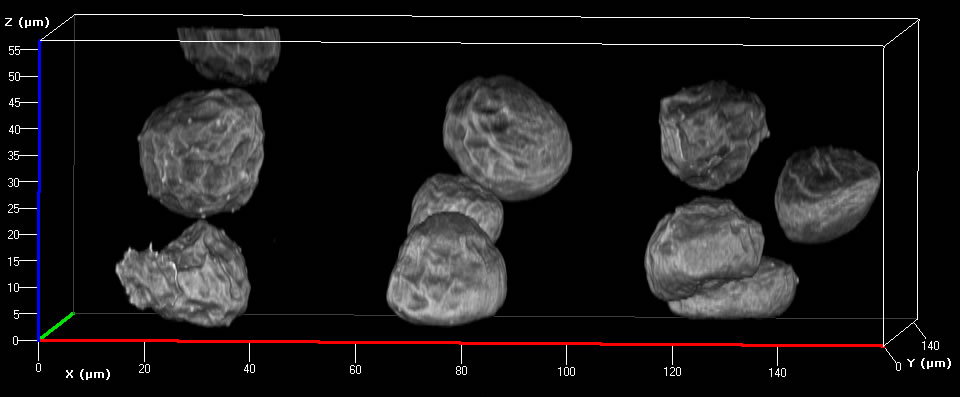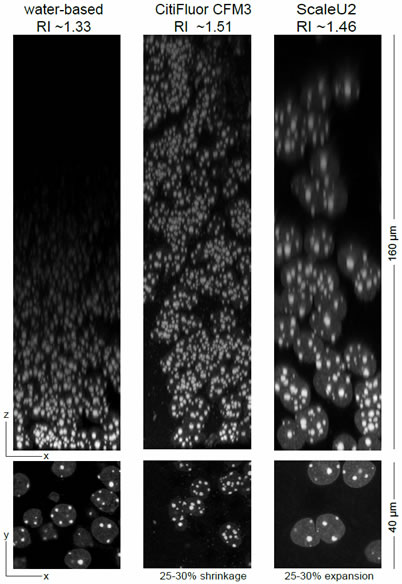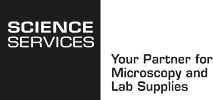Choosing the Best Antifadent (Anti-Bleaching Agent)
Critical decision factors to help you select the most appropriate Antifadent Solution:
-
Do you need a Hardening or a Non Hardening medium?
-
If your system is Glycerol tolerant than choose a Glycerol Based product, if not then use a Glycerol-Free solution.
-
High refractive index mountant solutions are used when effects of spherical aberration have to be obviated. Effects are caused by a mismatch between the refractive index of the cover slip glass and the mountant medium, which leads to a loss of resolution.
There is no universal antifadent due to the fact that biological material is so varied in nature that the fluorescence fading of fluorochromic conjugates is a complex process.
The general non-hardening antifadents are AF1, AF2, and AF3. The AF87 is a specialist immersion oil-based antifadent
If you are still unsure about which mountant media solution to use, please don’t hesitate to contact us. We have experienced technical staff on hand who are happy to answer the simplest, or the most challenging of questions.
Guide to Non-Hardening Mountants
Glycerol Based Mountants
-
AF1 is a glycerol-PBS solution contains an amine antifadent.
-
AF1 plus DAPI contains both an amine antifadent and the DNA stain, DAPI.
-
AF2 is a glycerol solution contains an amine antifadent that allows to choose your own buffer solution.
-
AF4 is a glycerol solution of with n-propyl gallate as antifadent.
Glycerol Free Mountants
-
AF3 is a PBS solution containing an amine-based antifadent.
- AFR3 is a PBS solution containing a NEW non-amine, non-phenolic antifadent.
High Refractive Index Glycerol Based Solutions
These solutions have a refractive index that matches that of the glass coverslip thereby minimizing effects of spherical aberration. Such mountants are precious for imaging internal structures of samples with high resolution confocal or multi-photon microscopy acting as an efficient Clearing Solution (clearing occurs within a few minutes – Sean Speese, Oregon Health and State University, Personal Communication).
Additional features of these solutions includes their total water miscibility, they are non-odorous and do not quench the fluorescence of fluorochromes (unlike thiodiethanol, another proposed high refractive index mountant) and the solutions are stable for long periods (at least 1 year).
All the following solutions have a refractive index of ~1.52 at room temperature (20°C) and are freely miscible with water. They may be used as an immersion oil in the standard way as well as a mountant solution. The refractive index of the materials makes them ideal for use when specimens are being examined by confocal laser scanning microscopy (CLSM)). They show very little absorption above 400nm.
The CFM range of mountant solutions should only be used with samples that have been fixed (4% paraformaldehyde in phosphate buffered saline for 30 minutes). The crosslinking (fixing) of the sample prevents non-covalently bonded fluorochromes e.g. DAPI, Hoechst dyes, from becoming detached from the specimen etc.
If some bleeding of the dye(s) is still observed a further fixation with paraformaldehyde should be carried out. For sealing the coverslips, when CFM mountant solutions are used, the product CoverGrip® marketed by Bioutium has been recommended (We are grateful to Dr. Sean Speese, Jungers Center for Neuroscience, Oregon, U.S.A. for these many helpful suggestions).
-
CFM-1 is a glycerol-PBS buffered solution having a refractive index of ~1.52, which can be used for transmission (bright-field)microscopy and epifluorescence microscopy.
-
CFM-1plus AF is a glycerol-based solution having a refractive index of ~1.52 (at room temperature) that contains an amine antifadent
-
CFM-2 is a glycerol-tris amine buffered solution having a refractive index of ~1.52 (at room temperature) and a pH of ~8.5
-
CFM-3 – This glycerol-based antifadent contains a phenolic antifadent of neutral pH and a refractive index of ~1.52 which also acts as a Clearing Solution enabling visualization of fluorochromes deep within the sample.
-
CFMR2 – This product was designed for use with samples labeled with GFP. It contains a unique antifadent which does not de-oxygenate the solution which is an essential property if the GFP is not to bleach.
The beneficial effects of these reagents can be seen in the two figures below where it can be seen that high resolution images have been obtained at a significant depth within the mountant solution.
The two images below are examples of Citifluor product applications, kindly provided by Dr Sean Speese:

Click on image above to see full size. 3D rendering of nuclei stained for LamDm0 in Drosophila tissue, mounted in CFM3 +antifade, imaged via confocal microscopy. Notice the staining intensity is consistent throughout the entire 55um stack with no increase in spherical aberration.
Courtesy: Dr Sean Speese and Stefanie Kaech Petrie, Jungers Center for Neurosciences Research Department of Neurology, Oregon

63×1.4 NA PlanApo / 1 Airy / Nyquist sampling xyz / Zeiss LSM 710 Genetically expressed GFP-tagged nuclear protein in brain slice.
Courtesy: Dr Sean Speese and Stefanie Kaech Petrie, Jungers Center for Neurosciences Research Department of Neurology, Oregon
High Refractive Index Glycerol Free Solutions
AF87 is an immersion oil having a refractive index of 1.52 and contains an antifadent. It may be used as an immersion oil and also as a mountant. Since AF87 is an oil that is immiscible with water, it is essential that specimens are dehydrated before application of the mountant.
Guide to Hardening Mountants
Hardening mountants are aqueous solutions containing a polymer such a poly (vinyl alcohol) (PVOH). When a few microliters of these solutions are pipetted onto a microscope slide and a coverslip applied, evaporation of water slowly takes place and the formation of a stable film results which immobilizes the coverslip.
A variety of hardening mountants is available which provide films possessing a range of hardness. They are based on water-soluble polymers such as poly(vinyl alcohol(PVOH) and poly (vinyl pyrrolidone)(PVP).
Film Forming Polymer Solutions
-
Tris-MWL 4-88 is a classical, popular mountant solution based on Mowiol® 4-88, glycerol, water and tris-amine buffer. Following evaporation of the water a film of weak to medium hardness is formed. To have effective reduction in photobleaching, it should be used with either AF200 or AF300.
-
CFPVOH is an aqueous solution of poly (vinyl alcohol) and is designed to be used with the glycerol-free antifadent AF100 or the glycerol-based antifadent AF200 or AF300. Following evaporation of the water films of medium hardness are produced.
-
Permafix PF is an aqueous solution of a chemically modified PVOH which may be used with AF200 or AF300 to give solutions which following loss of water by evaporation give films of medium to high hardness.
-
PVP plus antifadent is an aqueous solution of poly (vinyl pyrrolidone) containing an amine-based antifadent. The solutions are stable over long periods e.g. in excess of five years.
Glycerol Based additives for Hardening Mountants
-
AF100 is an aqueous PBS solution containing an amine-based antifadent.
Glycerol Based additives for Hardening Mountants
-
AF200 is a glycerol solution containing an amine-based antifadent.
-
AF300 is a glycerol solution containing a phenolic type of antifadent.
High Refractive Index Glycerol Free Solution
-
Permafix PF/HRF this is an aqueous solution of a chemically modified PVOH containing additives and is designed to yield films having a high refractive index (~1.52). Films having a moderate hardness are produced.



